Baseball Scorekeeping 101: How to Keep Score in Baseball
Reading Time: 13 minutes
Reading Time: 13 minutes
Baseball scorekeeping provides documentation of every game – creating the sport’s rich, deep history. It’s more than tracking how many runs each team scored. Outside of keeping official historical records, scorekeepers track statistics allowing coaches, players, and fans to analyze team and player performance.
The world of scorekeeping takes baseball knowledge and analysis to another level. To a newcomer, baseball scorekeeping may seem overwhelming or complex. Behind the shorthand language, there’s a better understanding of the game anyone can comprehend.
Whether you’re an official league scorekeeper, a dedicated parent volunteer, or an enthusiastic fan watching from home, this ultimate guide provides a comprehensive overview of baseball scorekeeping. Download our free baseball scorebook sheet to follow along as you read.
Continue reading to learn:
- The basics
- Best practices
- An overview of scorecards
- Notations and symbols
- How to keep score
- Scorekeeping for fans
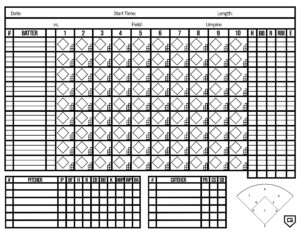
Baseball Scorekeeping Basics
What is baseball scorekeeping?
Baseball scorekeeping is the practice of recording every pitch, at bat, defensive play, and any other detail of a baseball game as it’s played. Official scorekeepers are designated by a team or league to keep the official historical game record, while casual fans keep score for a more engaging experience, to learn more about the game and baseball terminology, or any other reason.
Scorekeepers use a shorthand notation made of abbreviations, symbols, and numbering systems to record every detail of the game. This notation is universally recognized by baseball scorekeepers (with some variance) and makes it possible to provide thorough documentation on a scorecard’s limited space.
History of scorekeeping in baseball
The history of scorekeeping in baseball dates back to 1856. Sportswriter Henry Chadwick – originally a cricket enthusiast from England – attended a game between New York’s Gotham and Eagle baseball clubs where he fell in love with the sport.
The following year, he began covering baseball for The New York Clipper. Up until that point, baseball coverage focused more on the story of the game than statistics.
Chadwick strove to provide objective details and statistics to give readers a better idea of the game, and team and player performance. In doing so, he developed the first modern box score where he recorded runs, hits, putouts, assists, singles, and errors. He also coined the shorthand “K” for strike out and served as an influential member of baseball’s early rules committees.
Over time scorekeeping evolved into the thorough, detailed process that exists today. What once started as a box score transformed into scorecards and scorebooks. Today, the innovation of technology in sports has led to scoring apps on electronic devices.
Official Baseball Scorekeeping Practices
Anyone can be a baseball scorekeeper. Casual fans and unofficial scorers follow best practices like using shorthand notation and the player number system, but they don’t hold the same responsibilities as an official scorer.
Responsibility of the official scorer
The official scorer is a representative of the team or league and plays a significant role in a baseball game. They keep the official historical record of each game for league records, and team and player stats. Their records are used to determine a pitcher’s eligibility based on pitch count and rest requirements.
Outside of record keeping, the official scorer serves as an official source of judgement. They make the final decision on judgment calls like:
- Hit vs. error: deciding whether to credit the batter with a hit or the fielder with an error
- Wild pitch vs. passed ball: deciding whether to credit the pitcher with a wild pitch or the catcher with a passed ball
The scorekeeper also monitors any game errors. If a team starts to leave the field before three outs are made, the official scorekeeper alerts the umpire. Additionally, they communicate all decisions with the press box to make sure everyone is on the same page.
While an official scorekeeper has authority and respect, there are certain rules they must follow. The official scorekeeper cannot:
- Make any decisions that conflict the official playing rules or an umpires decision
- Alert the umpire that a player is batting out of turn
Baseball Scorecard Overview
The scorecard is a baseball scorekeeper’s lifeline. It’s how they keep score and document the game. When you first look at a baseball scorecard, there’s a good chance you’ll feel overwhelmed.
Break it into sections:
- Game overview
- Lineup (or batting order)
- Innings
- Score boxes (or event boxes)
- Player stats
- Team stats (or end of inning totals)
- Pitchers and catchers
Game overview
Scorecards provide areas to document high-level information about the game overview. This information can be consolidated in one section (often the lower right corner) or spread out in different areas, depending on the card’s design. On GoRout’s baseball scorebook card, it’s located across the top of the page.
The game overview typically includes:
- Team names (home and visiting)
- Location and/or stadium/field name
- Date
- Time (start and end)
- Umpires
- Scorekeepers
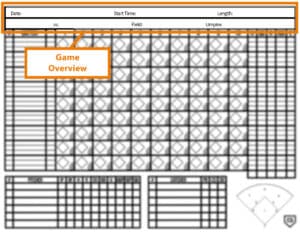
Lineup (or batting order)
In the left-most column of the scorecard, there are rows to list the lineup – or batting order. In each row, scorekeepers put the name and uniform number of starting players. It’s essential there are no mistakes. The lineup on the card must match the official batting order coaches submit to umpires.
How to fill out the lineup section
Start with the first batter in the lineup. Then, fill out the next batter and rest of lineup in sequential order down the column.
Within each row in the lineup column, there are two sub-rows – one for starters and one for substitutes. When filling out the lineup, write the name of each starter in the upper subrow. As players substitute, enter the substitutes name in the lower sub-row that corresponds with the position the player is substituting for.
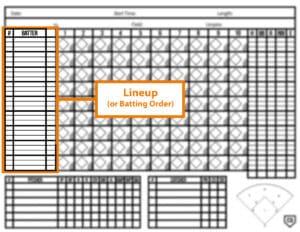
Innings
Next to the lineup column, there are individual inning columns. The number atop the column corresponds to the inning. Most baseball scorecard developers provide 10 to 12 inning columns – enough for any league standard plus a few for extra innings.
Within each inning column there are score boxes for every player in the batting order.
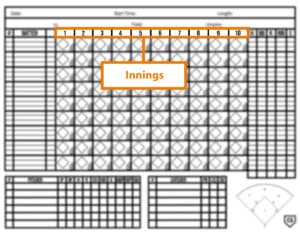
Score boxes (or event boxes)
Individual score boxes (or event boxes) document the minute details – tiny areas of the scorecard that host important notes about the game. There are individual score boxes for each player in every inning, though you don’t use all boxes every inning. Unless a team bats around, you rarely use every box in an inning.
Several elements make up a score box, including:
- Baseball diamond diagram: A diagram of the field and base paths that you use to document a base runner’s journey and other data
- Strikes and balls: Boxes (or other designs) where you track balls and strikes in an at bat
- Offensive results: Some of the most common results of an at bat (1B, 2B, 3B, HR, BB) are listed in the score box. You circle the appropriate play for each at bat.
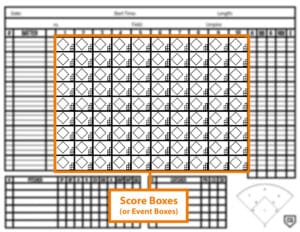
Player stats
On most scorecards, there’s a section to document individual player stats. There’s usually a table next to the final inning column with a variety of stats as headers. The table aligns with the lineup rows, so the proper players have space to record each of their stats.
Common player stats in baseball scorekeeping include:
|
ABBREVIATION |
STAT |
|
AB |
At Bats |
|
R |
Runs Scored |
|
2B |
Doubles |
| 3B |
Triples |
|
HR |
Home Runs |
|
SB |
Stolen Bases |
|
SAC |
Sacrifices |
|
HBP |
Hit By Pitch |
|
BB |
Walks |
|
SO |
Strikeouts |
| RBI |
Runs Batted In |
|
PO |
Put Outs |
| A |
Assists |
| E |
Errors |

Team stats (or end of inning totals)
Underneath the last player in the lineup – or a different location depending on scorecard developer – there is a section that provides a total of the team stats for each inning.
Team stats typically include:
- Hits
- Runs
- Errors
- Players left on base
Pitchers and catchers
Not all scorecards are designed the same way. Somewhere on the card, you’ll find a section to list and document stats for all pitchers and catchers that participate in the game.
Pitchers stats include:
- Win or loss
- Innings pitch
- Pitches thrown (some scorecards allow you to track pitches by inning)
- Batters faced
- Strikeouts
- Walks
- Hits
- Runs allowed
- Earned runs
- Wild pitches
- Hit batters
- Balks
For catchers, you track passed balls, caught stealing, and stolen bases.
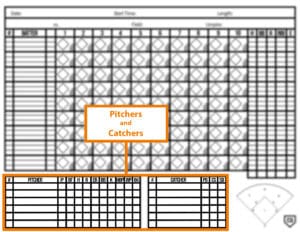
Baseball scorekeeping notations and symbols
There’s limited real estate on a baseball scorecard and a lot of information to document. It’d be impossible if you had to write out every play in full sentences.
To make sure every stat and note is recorded, baseball scorekeeping shorthand uses abbreviations, symbols, and number systems to describe play on the field.
Scorekeeping abbreviations
Baseball scorekeeping uses abbreviations to define and describe different types of offensive, defensive, and base running plays. Some abbreviations are used to track both offensive and defensive/pitching stats. For example, “K” is used to document a strikeout for both the pitcher and batter’s stat line.
Common scorekeeping abbreviations for offensive players include:
|
ABBREVIATION |
STAT |
|
1B |
Single |
|
2B |
Double |
|
3B |
Triple |
|
HR |
Home Run |
|
SAC |
Sacrifice |
| BB |
Walk |
|
IBB |
Intentional Walk |
| K |
Strikeout |
|
ꓘ |
Strikeout Looking |
|
FC |
Fielder’s Choice |
| HBP |
Hit By Pitch |
| RBI |
Runs Batted In |
|
F |
Fly Ball |
|
L |
Line Drive |
| f |
Foul Ball |
| B |
Bunt |
Common defensive and pitching abbreviations in scorekeeping include:
|
ABBREVIATION |
STAT |
|
BK |
Balk |
|
FC |
Fielder’s Choice |
|
WP |
Wild Pitch |
|
PB |
Passed Ball |
| DP |
Double Play |
| E |
Error |
|
IP |
Illegal Pitch |
| FO | Force Out |
| U |
Unassisted |
| I or CI |
Interference |
Scorekeeping abbreviations for base running include:
|
ABBREVIATION |
STAT |
|
SB |
Stolen Base |
| CS |
Caught Stealing |
Baseball positions by number: The player numbering system
Like abbreviations for plays and stats, baseball scorekeeping uses a number system to describe defensive players on the field. Imagine trying to score a base running pickle where seven defensive players touch the ball before making an out. You couldn’t fit every position’s full name and abbreviations aren’t concise enough.
The standard player numbering system for baseball scorekeeping is:
|
NUMBER |
POSITION |
|
1 |
Pitcher |
|
2 |
Catcher |
|
3 |
First Baseman |
|
4 |
Second Baseman |
| 5 |
Third Baseman |
| 6 |
Shortstop |
| 7 |
Left Fielder |
| 8 |
Center Fielder |
| 9 |
Right Fielder |
The standard numbering system makes it possible that an unlikely 1-3-6-2-4-9-8 scoring decision for a base runner in a pickle fits in the scorebook.
Note that softball has a tenth number (10) for the short fielder. The position doesn’t exist in baseball.

How to Keep Score in Baseball: Common Scorekeeping Practices
Balls and strikes
Balls and strikes are tracked in the score boxes. Within score boxes, there are smaller boxes or areas for balls and strikes – two for strikes and three for balls.
There are three methods to document balls and strikes:
- Strike a line through the area
- Color the area in completely
- Number (marking balls and strikes by pitch number)
Any of these methods get the job done. For more precise tracking, use pitch numbers. Remember to number pitches in the order they occurred. If a pitcher throws a ball, two strikes, and another ball, they would mark “1” and “4” in the ball areas and “2” and “3” in the strikes.
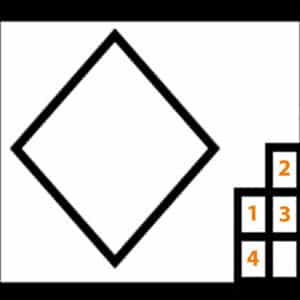
Outs
When documenting outs, you need to know where the ball went, who it was thrown to, or who caught it. Write the position number of the player that fields the ball, and any subsequent player who participates in the play.
Groundout notation is the standard for documenting ground outs. First write the number of the player that fields that ball. Then, write the numbers of any players who receive the ball – separating players with a dash (-).
Here are a few examples of groundout notation:
- Groundout to shortstop = 6-3
- Double play fielded by the shortstop then tossed to the second baseman who throws to the first baseman = 6-4-3
For plays to the outfield, some scorekeepers use only the number while others use a play abbreviation and player number. For example, a fly out to left field would either be “7” or “F7” depending on preference. A line out to right field would be “9” or “L9”
Regardless of the type, mark each out in the score box where it occurred – putting a 1, 2, or 3 depending on which out it is and circling the number.
Draw a half line towards the base where the out was made. If it’s a ground out, draw half a line toward first base. If a runner is thrown out trying to extend a single into a double, draw a line all the way to first base and then a half line from first to second base.
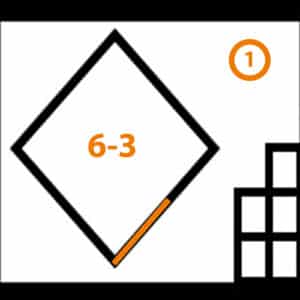
Hits
Tracking hits is relatively straightforward. Many scorebooks have basic at bat results (1B, 2B, 3B, HR, BB) listed in each score box. Circle the appropriate result for each batter. If there’s no hits listed, write it in an open space in the score box.
For hits, draw a line (or multiple lines) to the base the batter made it to. If scoring a triple, draw a line from home to first, first to second, and second to third.

When a hit occurs, advance each player on base to the correct position in their respective box. If a runner advances from first to third base on a double, you would:
- Draw a line from home to first, and first to second base in the batter’s score box
- Draw a line from first to second base, then second to third in the runner’s score box
Walks
Walks are scored the same way as a hit. The only difference is you circle the BB abbreviation (or write BB) and draw a line to first base.
If there’s a walk with bases loaded, the hitter is credited with an RBI.

Strikeouts
Use the letter “K” to indicate a strikeout where the batter swings. If the hitter struck out looking, use a “ꓘ” (backward K).
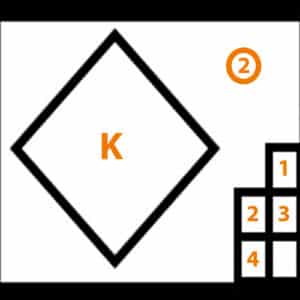
Runs & RBIs
To indicate a base runner scored, color in the entire baseball diagram in the runner’s score box.
In the batters score box, mark “RBI” in an open space to credit them with the RBI.
End of inning
At the end of each half inning, draw a slash in the bottom right corner of the player who makes the last out. Alternatively, you can draw a horizontal line across the bottom of that player’s score box that extends to the next inning. That way, there’s a line across the bottom of the player who makes the last out and a line across the top of the player who will start the following inning.
Draw a line through or cross out all unused score boxes at the completion of each inning so no accidental scoring occurs.
Player changes
When substitutions occur, write the new player’s name in the position of the lineup where they’ll be substituting. Remember to write their name in the lower sub-box underneath the starting player’s name.
Indicate what inning the change was made. Use a “T” to indicate top of the inning and “B” to indicate bottom.
Mark a vertical line on the right hand side of the score box where the new player entered. For a pitching change, mark a horizontal line at the bottom of the score box where the change occurs.
Fielder’s choice
A fielder’s choice occurs when a defensive player makes a force out on a ground ball that allows the batter to reach first base. The fielder chooses to get a different baserunner out instead of the batter.
To properly score a fielder’s choice, mark a full line to the base the batter reached and write FC next to the line in the batter’s score box. Mark a half line to the base the runner that was thrown out at and enter the proper scoring notation in the runner’s score box.
For example, let’s use a ground ball to the shortstop where the runner is forced out at third. In the batter’s score box, draw a line from home to first base and write FC next to it. Draw a half line from second to third base and write 6-5 FC next to it in the runner’s score box.
Errors
Errors should be marked on the base path the runner advances to because of the error. For example, an errant throw by the second baseman that allows a runner to advance to second should be marked “E4” just above the base path line from first to second base.
Passed balls and wild pitches
Passed balls and wild pitches may look similar, but they impact the pitcher and catcher in different ways.
A passed ball is where the catcher drops or misses the ball on a pitch that should’ve been caught. To score, write “PB” on the baseline the runner advances to.
- For example, on a passed ball allowing a runner from first to second, write “PB” on the line going from first base to second base.
A wild pitch is when the ball bounces before it reaches the plate or is thrown so poorly the catcher has no chance to receive it. Score a wild pitch the same way you do a passed ball, but indicate it with “WP” instead.
Baseball Scorekeeping for Fans
Scorekeeping offers a more engaging experience for avid baseball fans. Instead of just watching a game, keeping score allows you to actively participate. If you’re a diehard enthusiast of the game, you can use scorekeeping as a way to stay engaged when you have no connection or stake in the teams playing. On the flip side, you can use it to feel more connected with your favorite team as you follow through the season.
It’s also a way for new fans to learn about the game and how it works. Even if you only track basic stats and plays, scorekeeping offers guidance to understanding baseball.
You can buy or download pre-made scorecards or create your own. GoRout offers a baseball scorebook card that you can download for free!
FAQs About Baseball Scorekeeping
What does scorekeeping mean in sports?
In sports, scorekeeping means tracking every play and key statistics of a game on a scorecard for official documentation. Every sport – including baseball, softball, and football – uses scorekeeping as the official record of a game.
Scorekeeping also refers to casual fans documenting the game on a scorecard for personal pleasure, to better understand the game, or for other reasons.
What does “5-4-3” mean?
In baseball, “5-4-3” refers to the scoring notation of a ground ball double play involving the third baseman, second baseman, and first baseman.
In a “5-4-3” double play:
- The third baseman fields the ground ball and throws it to second base
- The second baseman receives the throw, steps on the bag for a force out, and throws to first base
- The first baseman receives the throw, completing the double play
What is the hobby of baseball scorekeeping?
When baseball scorekeeping is a hobby, that means you record every play and key statistic on a scorecard that is not an official record of the game. This differs from the official scorekeeper who records the game as official documentation for a team or league.
Casual fans, sports enthusiasts, or anyone with interest can take up baseball scorekeeping as a hobby. Whether you physically attend the game or watch on TV or streaming, you can keep score on your own card.
How do you become a baseball scorekeeper?
You need a sound understanding of the rules of the game and official baseball scoring rules to become a baseball scorekeeper. There is no school or “official certification” to attend, but you need to know game strategy, player’s roles, and a deep knowledge of baseball statistics.
To get started and gain experience, score games on your own or volunteer to keep score for lower levels of baseball. From there, work to build connections and monitor job openings until you find the right opportunity. In Major League Baseball (MLB), many job opportunities are tied to networking.
Depending on the level and league you work for, there is some level of training to make sure you’re complying with league-specific scorekeeping standards.







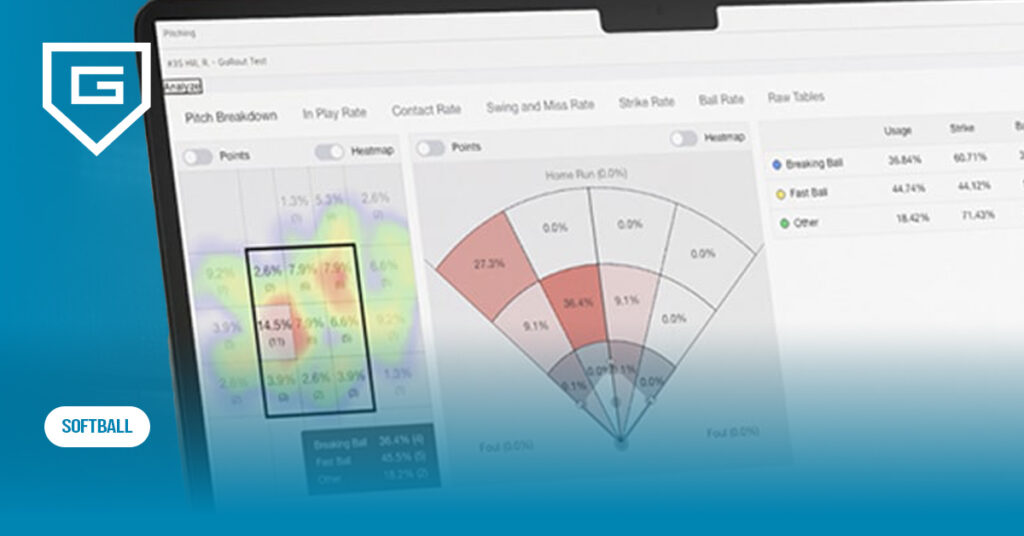
My scorebook at the right edge of the paper has boxes for At Bat / Runs / Hits / RBI / Strike Out / Base on Balls and then errors. In the errors box do you mark the errors each batter made while fielding or do you mark the errors made by the defense while they were at bat?
You mark the errors that the respective batter made while they’re in the field. For example: If a team’s second baseman had three hits and a strikeout along with an error, you would mark all of those statistics in the right edge of the second-baseman’s row in the lineup card.